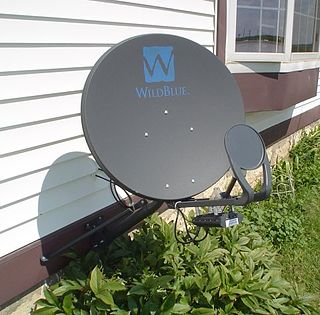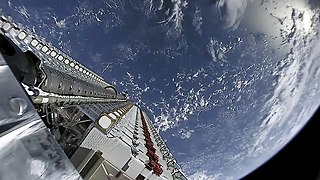Related Research Articles

Free-space optical communication (FSO) is an optical communication technology that uses light propagating in free space to wirelessly transmit data for telecommunications or computer networking. "Free space" means air, outer space, vacuum, or something similar. This contrasts with using solids such as optical fiber cable.
The Ka band is a portion of the microwave part of the electromagnetic spectrum defined as frequencies in the range 26.5–40 gigahertz (GHz), i.e. wavelengths from slightly over one centimeter down to 7.5 millimeters. The band is called Ka, short for "K-above" because it is the upper part of the original NATO K band, which was split into three bands because of the presence of the atmospheric water vapor resonance peak at 22.24 GHz (1.35 cm), which made the center unusable for long range transmission. The 30/20 GHz band is used in communications satellite uplinks in either the 27.5 GHz and 31 GHz bands, and high-resolution, close-range targeting radars aboard military airplanes. Some frequencies in this radio band are used for vehicle speed detection by law enforcement. The Kepler Mission used this frequency range to downlink the scientific data collected by the space telescope.

Satellite Internet access or Satellite Broadband is Internet access provided through communication satellites. Modern consumer grade satellite Internet service is typically provided to individual users through geostationary satellites that can offer relatively high data speeds, with newer satellites using Ku band to achieve downstream data speeds up to 506 Mbit/s. In addition, new satellite internet constellations are being developed in low-earth orbit to enable low-latency internet access from space.
Optical networking is a means of communication that uses signals encoded in light to transmit information in various types of telecommunications networks. These include limited range local-area networks (LAN) or wide area networks (WANs), which cross metropolitan and regional areas as well as long-distance national, international and transoceanic networks. It is a form of optical communication that relies on optical amplifiers, lasers or LEDs and wavelength-division multiplexing (WDM) to transmit large quantities of data, generally across fiber-optic cables. Because it is capable of achieving extremely high bandwidth, it is an enabling technology for the Internet and telecommunication networks that transmit the vast majority of all human and machine-to-machine information.
The European Data Relay System (EDRS) system is a European constellation of GEO satellites that relay information and data between satellites, spacecraft, UAVs, and ground stations. The first components were launched in 2016 and 2019.
Stellar Project is a space technology startup manufacturing laser communication equipment and providing optical satellite communication equipment.

Planet Labs PBC is an American public Earth imaging company based in San Francisco, California. Their goal is to image the entirety of the Earth daily to monitor changes and pinpoint trends.
Optical wireless communications (OWC) is a form of optical communication in which unguided visible, infrared (IR), or ultraviolet (UV) light is used to carry a signal. It is generally used in short-range communication.

Laser communication in space is the use of free-space optical communication in outer space. Communication may be fully in space or in a ground-to-satellite or satellite-to-ground application. The main advantage of using laser communications over radio waves is increased bandwidth, enabling the transfer of more data in less time.

Starlink is a satellite internet constellation operated by American aerospace company SpaceX, providing coverage to over 60 countries. It also aims for global mobile phone service after 2023.

Capella Space is an American space company. It is developing space-based radar Earth observation satellites equipped with synthetic-aperture radar that can penetrate clouds and work at night. The company is based in San Francisco, California. It was founded by Payam Banazadeh, a former engineer at Jet Propulsion Laboratory of NASA, and William Walter Woods.
A satellite internet constellation is a constellation of artificial satellites providing satellite internet service. In particular, the term has come to refer to a new generation of very large constellations orbiting in low Earth orbit (LEO) to provide low-latency, high bandwidth (broadband) internet service.
L3Harris Technologies, Inc. is an American technology company, defense contractor, and information technology services provider that produces command and control systems and products, wireless equipment, tactical radios, avionics and electronic systems, night vision equipment, and both terrestrial and spaceborne antennas for use in the government, defense, and commercial sectors. They specialize in surveillance solutions, microwave weaponry, and electronic warfare. It was formed from the merger of L3 Technologies and Harris Corporation on June 29, 2019, and was expected to be the sixth-largest defense contractor in the United States.
Warpspace is a private Japanese company developing an inter-satellite communication system based on laser communication. Warpspace is developing a medium Earth orbit satellite, WarpHub InterSat, which will communicate with other satellites in low Earth orbit using optical communication, then pass on the received data to ground stations.
The German Flying Laptop satellite, launched on 14 July 2017 on a Soyuz launch vehicle from Baikonur Cosmodrome in Kazakhstan, hosts the OSIRISv1 laser communications experiment. The satellite has a total mass of 110 kg. It operates at a 600 kilometres (370 mi) Sun-synchronous orbit with an inclination of 97.6 degrees.
Optical Space Infrared Downlink System (OSIRIS) is an experimental program of DLR's Institute of Communications and Navigation.

The Space Development Agency (SDA) is a United States Space Force direct-reporting unit tasked with deploying disruptive space technology. A primary focus is space-based missile defense using large global satellite constellations made up of industry-procured low-cost satellites. The SDA has been managed by the United States Space Force since October 2022. By September 2023 the SDA had 23 satellites on orbit. SDA targets to have at least 1,000 satellites in low Earth orbit by 2026.

In 2022, amidst the Russian invasion, Ukraine requested American aerospace company SpaceX to activate their Starlink satellite internet service in the country to replace internet and communication networks degraded or destroyed during the war. Starlink has since been used by Ukrainian civilians, government and military. The satellite service has served for humanitarian purposes, as well as defense and attacks on Russian positions.
Bulent Altan is a Turkish-American aerospace executive and engineer, known for his significant contributions to SpaceX, an American aerospace manufacturer and space transportation services company headquartered in Hawthorne, California. He was also CEO of laser communications manufacturer Mynaric and is founding partner of venture capital firm Alpine Space Ventures.
References
- 1 2 "Fibreless optical links in the skies | Mynaric". www.edisoninvestmentresearch.com. Retrieved 7 April 2018.
- 1 2 Laser terminals from DLR and its spin-off, Mynaric, inducted into the 'Space Technology Hall of Fame'. DLR. 16 February 2018.
- ↑ Belz, Lothar (2013-12-19). "Optical data link successfully demonstrated between fighter plane and ground station". Archived from the original on 2013-12-30.
- ↑ "DODfast: Laserkommunikation zwischen Jet und Bodenstation". DLR Portal (in German). Retrieved 10 April 2018.
- ↑ "IPO Of The Mynaric AG In Frankfurt Stock Exchange's Scale Segment - Initial Price: 53.75 Euro - Investors Used Public Subscription Via Exchange". www.mondovisione.com. Retrieved 7 April 2018.
- ↑ "Mynaric lasert sich an die Börse | Aktien News | boerse.ARD.de". boerse.ARD.de (in German). Retrieved 7 April 2018.
- ↑ "34th Space Symposium's 2018 Space Technology Hall of Fame Inductees are Aluminum Alloy 398 and Miniaturized Laser Terminals". www.satnews.com. Retrieved 7 April 2018.
- ↑ "Lasercom Tech for Satellites and Constellations Under Development by Mynaric and Leti". www.satnews.com. Retrieved 10 April 2018.
- ↑ "Leti and Mynaric partner on APDs for FSO aircraft/drone/satellite constellation networks". www.laserfocusworld.com. Retrieved 13 April 2018.
- ↑ Price, Rob (29 June 2018). "Facebook tested plane-mounted lasers that fire super high-speed internet over California — here are the photos". Business Insider. Retrieved 21 July 2018.
- ↑ Henry, Caleb (14 March 2019). "Former SpaceX Starlink exec joins German lasercomm startup". SpaceNews.com. Retrieved 9 April 2019.
- ↑ Henry, Caleb (19 March 2019). "Mynaric raises $12.5 million from mystery constellation customer". SpaceNews.com. Retrieved 9 April 2019.
- ↑ Sheetz, Michael (19 November 2021). "German space lasers company Mynaric CEO talks Nasdaq IPO, plans for growth". CNBC. Retrieved 16 December 2022.
- ↑ Henning, Eyk (12 November 2021). "Laser Firm Mynaric Said to Draw Peter Thiel, ARK to U.S. Listing". Bloomberg.com. Retrieved 16 December 2022.
- ↑ Erwin, Sandra (14 June 2022). "Northrop Grumman demonstrates Mynaric laser terminals for military constellation". SpaceNews. Retrieved 16 December 2022.
- ↑ Foust, Jeff (6 July 2022). "L3Harris makes strategic investment in Mynaric". SpaceNews.
- ↑ Erwin, Sandra (21 June 2023). "Mynaric to supply laser communications for Raytheon's missile-tracking satellites". SpaceNews.
- ↑ Jordanova-Duda, Matilda (2019-02-07). "Datenreise per Laserstrahl". vdi-nachrichten.com. Archived from the original on 2019-02-18. Retrieved 2019-02-18.